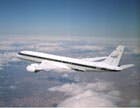Aircraft passengers and crews will be able to drink safer water under new regulations proposed by the U.S. Environmental Protection Agency (EPA). The proposed Aircraft Drinking Water Rule (ADWR) will tailor existing health-based drinking water regulations to fit the unique characteristics of aircraft public water systems. The rule will protect the public from illnesses that can result from microbiological contamination.
"We're upgrading airline drinking water standards to first-class status with better testing, treatment and maintenance," said Assistant Administrator for Water Benjamin H. Grumbles.
In 2004, the EPA tested aircraft drinking water quality and reviewed air carrier compliance with regulations. EPA found that 15% of tested aircraft tested positive for total coliform bacteria. The agency also found that air carriers were not meeting existing regulations, primarily because those regulations were designed for stationary public water systems. In response, EPA began a process to tailor the existing regulations for aircraft public water systems and placed 45 air carriers under administrative orders on consent that are in effect until aircraft drinking water regulations are final.
The proposed ADWR will protect drinking water through monitoring, disinfection, and public notification, a combination that the EPA believes will better protect public health. The approach will build on existing aircraft operations and maintenance programs and better coordinate federal programs that regulate aircraft water systems.
The proposed ADWR applies to the aircraft's onboard water system only. The Food and Drug Administration is responsible for regulating the airport watering points that include the water cabinets, carts, trucks and hoses from which aircraft board water. The EPA and the states are responsible for regulating public water systems that supply drinking water to the airport watering points. While the proposed rule only addresses aircraft within U.S. jurisdiction, the EPA is also supporting an international effort led by the World Health Organization to develop international guidelines for aircraft drinking water.
More information about aircraft drinking water: www.epa.gov/airlinewater/regs.html.
Source: EPA


